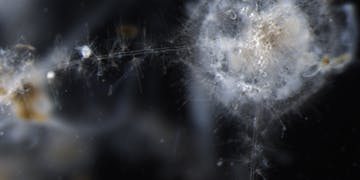When MBARI’s remotely operated vehicles, or ROVs, dive into the deep sea, we descend through flurries of tiny particles that look like snow. We call this “marine snow”—a mixture of dead plankton, waste, mucus, and other organic material slowing sinking from the ocean’s surface.
In 2021, MBARI welcomed biological oceanographer Colleen Durkin to MBARI’s science team. Durkin’s research takes a closer look at marine snow to reveal the ecology of carbon export from the surface ocean into the deep sea.
Marine snow is a vital food source for many deep-sea animals. Many animals in the midwater—the expanse of water deep below the ocean’s surface but still far above the deep seafloor—feast on the rain of organic material drifting down from above. The many mouths of the midwater eat most of the marine snow sinking from the surface, but some still reaches the seafloor, where it becomes food for sea cucumbers and other animals.

These sinking particles of organic material also represent a key part of the ocean’s carbon cycle. Tiny phytoplankton at the ocean’s surface convert carbon dioxide into oxygen and organic matter. When phytoplankton are eaten or die, they enter the biological carbon pump, exporting carbon from the surface to the deep sea.
However, the amount of carbon transported away from the atmosphere and sequestered in the deep sea by these sinking particles is difficult to observe and challenging to predict. These difficulties stem, in part, from the complex ecological interactions involved in generating and transporting sinking carbon. Because we do not fully understand the export of carbon from the surface through the midwater, we cannot accurately quantify the ocean’s carbon cycle, how it is changing, and the impacts on ocean ecosystems.
Durkin’s lab seeks to fill in the gaps in our understanding of the ocean’s carbon cycle by taking a closer look at marine snow. What controls the export of surface phytoplankton production? How do deep-sea ecosystems transform sinking particles, either enhancing or attenuating carbon flux? How can advanced instrumentation be used to make detailed biological observations of carbon export at regional and global scales?
Durkin’s research seeks to resolve these microscopic—and oftentimes beautiful—interactions with marine snow to develop a quantitative understanding of the ocean’s carbon cycle. She plans to use MBARI’s engineering resources to expand our ability to directly observe carbon export into the deep sea through the development of persistent, high-resolution, and long-term imaging technologies. These technological and observational approaches provide the infrastructure to collect samples and resolve the biological details controlling carbon export into the deep sea.

Direct monitoring of carbon sequestration will be needed for many of the carbon-capture strategies currently being proposed to mitigate climate change. Durkin’s work could provide a mechanism to quantify the effectiveness and ecological impacts of these ocean-based climate mitigation plans. More fundamentally, an accurate accounting of the ocean’s carbon cycle is needed to generate more precise models and predictions of changing global climate. This work will provide the observations necessary to develop these advanced models.
“The ocean holds a complex microscopic world that exists outside of our everyday field of view. The core mission of my work is to resolve those microscopic processes in all their beauty, and directly link them with their influences on large-scale ecosystems and our climate.” —MBARI Scientist Colleen Durkin
